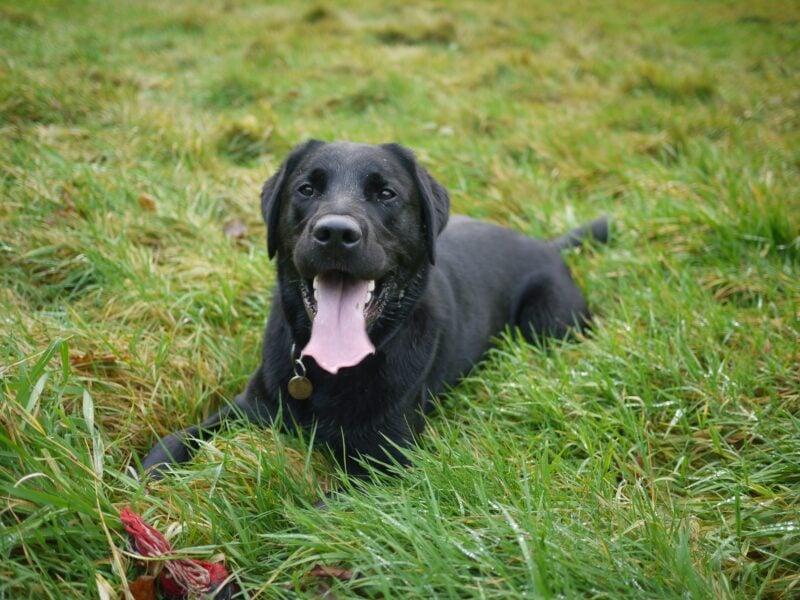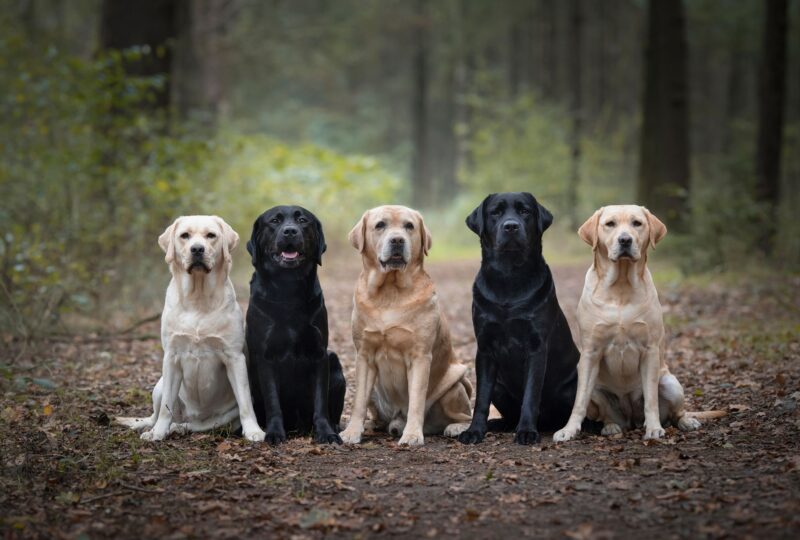There are a lot of lab mixes in the world because the Labrador retriever has long been one of the most popular breeds registered with the American Kennel Club. Some lab hybrids are created on purpose, such as the labradoodle created by breeding a poodle and a lab. If you are curious about how to breed Labradors, you can learn more by using scientific tests, your observational skills, or both to determine what your lab is mixed with.
The dense, short, and straight coat of the Labrador is one of his distinguishing characteristics, per the AKC breed standard. Hes a medium-size dog, standing between 21. 5-and-24. 5 inches tall, and weighing between 55-and-80 pounds. Depending on the color of his coat, he has an athletic build, a wide head, and brown or hazel eyes.
The Labrador retriever is a smart, interesting dog who enjoys spending time with her family, which may account for why she has remained so popular over time. She enjoys engaging in a variety of activities as an active dog, including swimming, hiking, and jogging, and she won’t mind working either. The hunting, search-and-rescue, and sniffer dog abilities of labradors are well known. She is a dog that enjoys being trained and is eager to please.
You may be able to determine the breed of dog your Lab mix is if you closely observe his behavior. Dogs are often bred for certain behavioral traits. For instance, herding dogs are bred for their ability to guard and move other animals, which frequently shows in their personality and regular behavior. Dog types and their behavior characteristics include:
Watch your dogs behavior and note any behavior patterns. For instance, whether he constantly sniffs and follows scent trails or prefers to pursue squirrels. It will be easier to determine what other breeds may be present in his genetic makeup if you are aware of his personality traits.
Consider dog breeds with prick ears, such as the German shepherd, if your dog has a classic Lab coat but pointy ears. A curly or wiry coat may indicate poodle genes. The size of one of the parents can be determined by a Labrador mix that is larger or smaller than average.
By paying to have a deoxyribonucleic acid or DNA test done on your dog, you can find out more about its ancestry. Many tests are accessible online and only call for a quick cheek swab from your dog, which is sent in to be compared to a database of numerous dog breeds. If you decide to use a DNA test, keep in mind that the more breeds the provider has in its database, the higher the likelihood that the results will be accurate. In general, the chance of correctly identifying each dog’s breed increases with the number of breeds present.
The Basics of the Labrador Retriever

It’s crucial that we discuss a few Labrador basics before introducing you to some of the cutest Lab mixes around. You can use this to determine if a Lab mix would be a good fit for your family.
As you can see, Labs are undoubtedly one of the world’s most attractive breeds and have a lot to offer the right family. However, no dog breed is ideal for every situation or scenario.

Without further ado, here are some Labrador designer breeds that are sure to win your heart among the many adorable canine crosses available.
Mixed-breed dogs have few “official” names; the majority simply have a catchy mashup of their two parent breeds.
In some instances, like the Labradoodle (a Labrador retriever and a poodle mix), the names are quite well known and frequently used.
But in other instances, a specific mix really doesn’t have a widely recognized name.
So please don’t take the names of these mixes too seriously, and be sure to let us know in the comments what your favorite alternatives are.
Aussiedor (Labrador Retriever X Australian Shepherd)
Make sure you’re prepared to provide plenty of exercise time before bringing one of these Australian Shepherd Labs into your family. Labs already have fairly high energy levels on their own, but when you combine a Lab with an Australian shepherd, you get a high-octane pooch that is READY TO ROCK at all times.
Additionally, some Australian Shepherd Lab mixes produce pups with adorable coat color patterns, which only serves to increase their appeal. These pups are best paired with active owners.
Afador – Labrador Afghan Hound mix
A cross between a Labrador Retriever and an Afghan Hound is known as an Afador. Given the low population of Afghan hounds, they are relatively uncommon. Given that Afghan Hounds and Labradors are both relatively tall dogs, your Afador puppy is likely to grow to be quite large. Compared to their Lab friends, Afghans are more leggy and have longer muzzles and very long straight coats.

As a result, you might end up with a dog with medium to long fur that needs regular grooming.
Afghan temperaments tend to be less outgoing and enthusiastic for everyone they meet than Lab temperaments. However, you cannot anticipate whether this trait will be passed on to your Afador puppy.
Afghans tend not to have the same level of confidence that most Labs do naturally, and they are just as likely to experience behavioral issues if regularly left alone for extended periods of time. For these reasons, socialization is crucial. Afghans, like Labradors, require a similar amount of exercise and positive training to develop into well-mannered members of the family.
Afghan Hounds typically live to be around 12 years old, about the same lifespan as Labradors. However, because mixed-breed dogs typically live longer than purebred dogs, your Afador has a good chance of living longer than this. Make sure the parents of your Afador puppy have undergone thorough health screenings for the inherited diseases prevalent in their respective breeds if you are purchasing a puppy.
The parent of an Afghan hound must at the very least have thyroid testing, a hip score of less than 8, and clear eyes less than a year old.
The Bassador is another uncommon cross, but one that some people find to be very appealing. This Labrador/Basset Hound cross can produce a canine that generally resembles a short-legged, large-eared Labrador. Adults typically measure 14 inches tall, with body proportions that fit a larger breed of dog and short legs.

The average lifespan of a Basset Hound is 11 years, making it slightly less than that of a Labrador Retriever. Additionally, they have some concerning structural and health issues that you must consider. This breed frequently experiences Ectropion, a condition in which the bottom eyelid rolls upward, exposing the lower portion of the eye and possibly causing discomfort and surface damage. They have a lot of loose skin, especially underneath and on top of their heads. Due to this, they are at a greater risk of developing itchy yeast and bacterial skin infections.
Additionally, because of the Basset’s relatively high weight-to-height ratio and their disproportionately long legs compared to their bodies, they may experience mobility problems and arthritis. The real danger here is that you might end up with the boisterousness and enthusiasm of a Labrador in a body that isn’t built to handle it.
The Labrador parent must have a PRA clear, clear eye test, a cumulative hip score of less than 9, and elbow scores of zero, at the very least. For full health testing for Labs check out this article. The parent Basset Hound should have 0 elbow scores, tight eyelids, and a clear gonioscopy test. They should have longer than average legs and the least amount of loose skin possible.
If you have your heart set on a Bassador, you should start your search with working line Basset Hounds because they are frequently in much better condition than their show bred cousins. Learn more about the issues that Basset Hounds deal with and the distinctions between show and working lines here.
If properly trained, Border Collies are highly intelligent dogs that get along well with their owners. They are very much a ‘one person’ dog. Loyal to their families, and fairly indifferent to everyone else. They can be taught a dizzying array of activities through positive reinforcement training, and they pick things up quickly.

There are currently a few different Border Collie strains as well, and the personalities of those from the Show, Agility/Flyball, and Working lines all vary quite a bit from one another. Even though they are high energy dogs who need a lot of stimulation, show dogs are typically the least motivated.
Like Labs as puppies they can be very nippy, and in the case of Collies this can express quite strongly around children as they attempt to herd them around, so it will be complete luck of the draw what you end up with. Therefore, it is generally advised against them for families with very young children. However, when older, they frequently make wonderful pets for active, busy families who enjoy training and cooperating.
You must be ready that your Lab mix may have a long coat that requires a lot of grooming because these are beautiful dogs. They reach a maximum height of about 21 inches, making them slightly smaller than the typical Labrador.
Despite being known for living long lives, studies show that Border Collies’ median age is actually comparable to that of Labrador Retrievers at 12 years of age. Given that mutts live longer on average, your dog would have a good chance of living a longer, healthier life as long as they avoid diseases specific to their breed.
The Labrador parent must have a PRA clear, clear eye test, a cumulative hip score of less than 9, and elbow scores of zero, at the very least. For full health testing for Labs check out this article. Clear test results for Choroidal Hypoplasia, CL, IGS, MDR1, and TNS should be obtained from the Border Collie parent. On the Kennel Club website, click here, you can learn more about these. In a busy household with people present for most of the day and able to give them the concentrated attention their bodies and brains need, a healthy Borador could make an incredible pet.
The Labrahuahua is most likely the most extreme Labrador Retriever cross you will ever see. And it’s unlikely that you’ll encounter this combination very frequently.
You can learn more about this strange mix breed in the link below. From a purely practical point of view, the barriers to an accidental mating are pretty big.
FAQ
Are Lab mixes hard to train?
Labs are simple to train because they have a natural work ethic and intelligent temperament. They make excellent pets because they are amiable and less aggressive than other dog breeds.
What is the best breed to mix with a Lab?
Given the similarities between Vizslas and Labradors, this is one of those canine combinations that should (theoretically) be fairly simple to predict. They are both sensitive, energetic, and affectionate dog breeds, making them ideal for owners who want to spend a lot of time with their dog.
Are Lab mixes protective?
Yes, Lab-pit bull mixes are excellent kids. They will be fiercely protective of their young charges and are kind and playful.
What are Lab mixes like?
These medium-sized, energetic puppies require a lot of exercise to remain happy. Additionally, you’ll need a house with a sizable backyard where your dog can run around and play. The temperament and personalities of the Lab mix’s parent breeds differ greatly.
